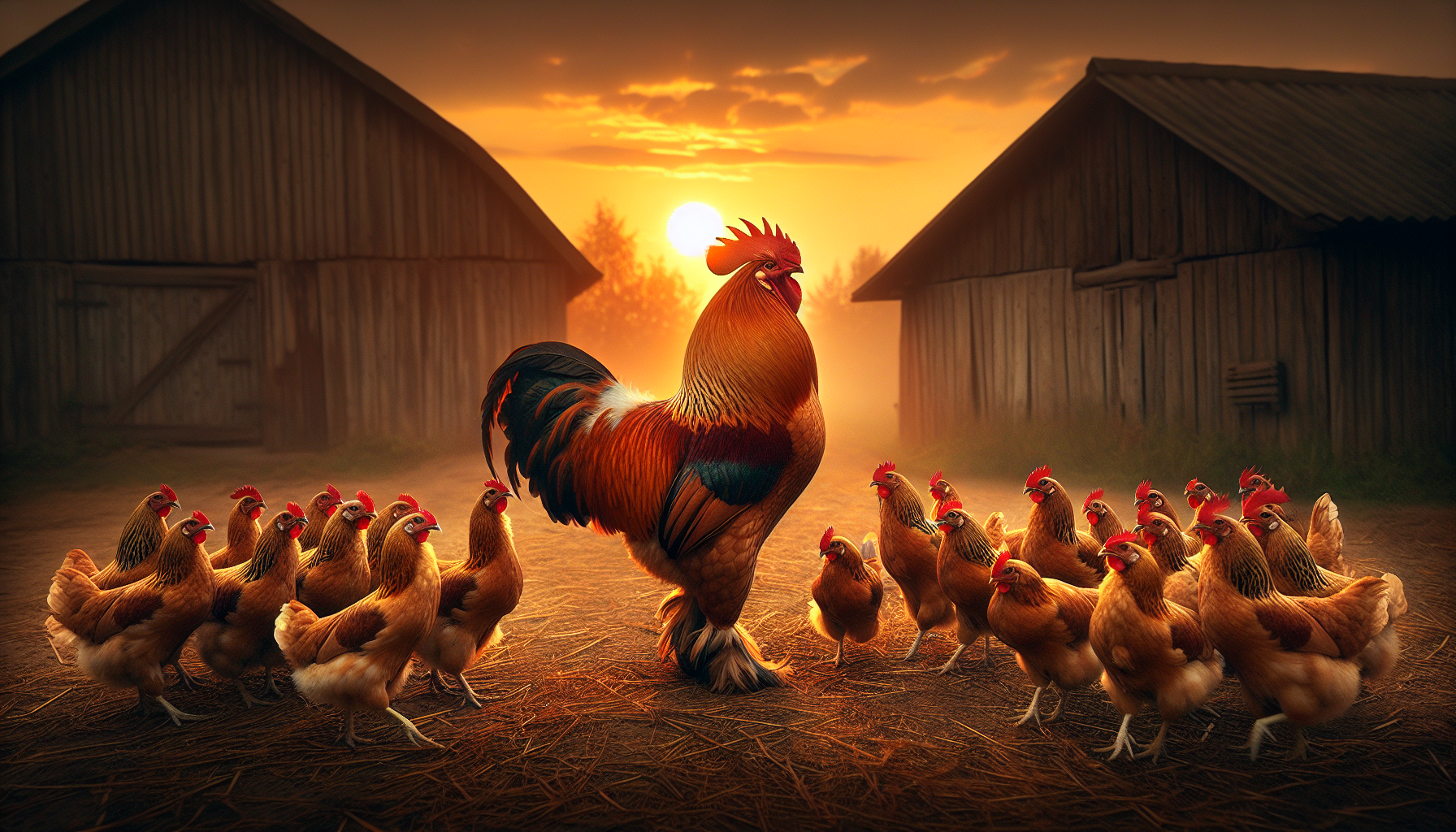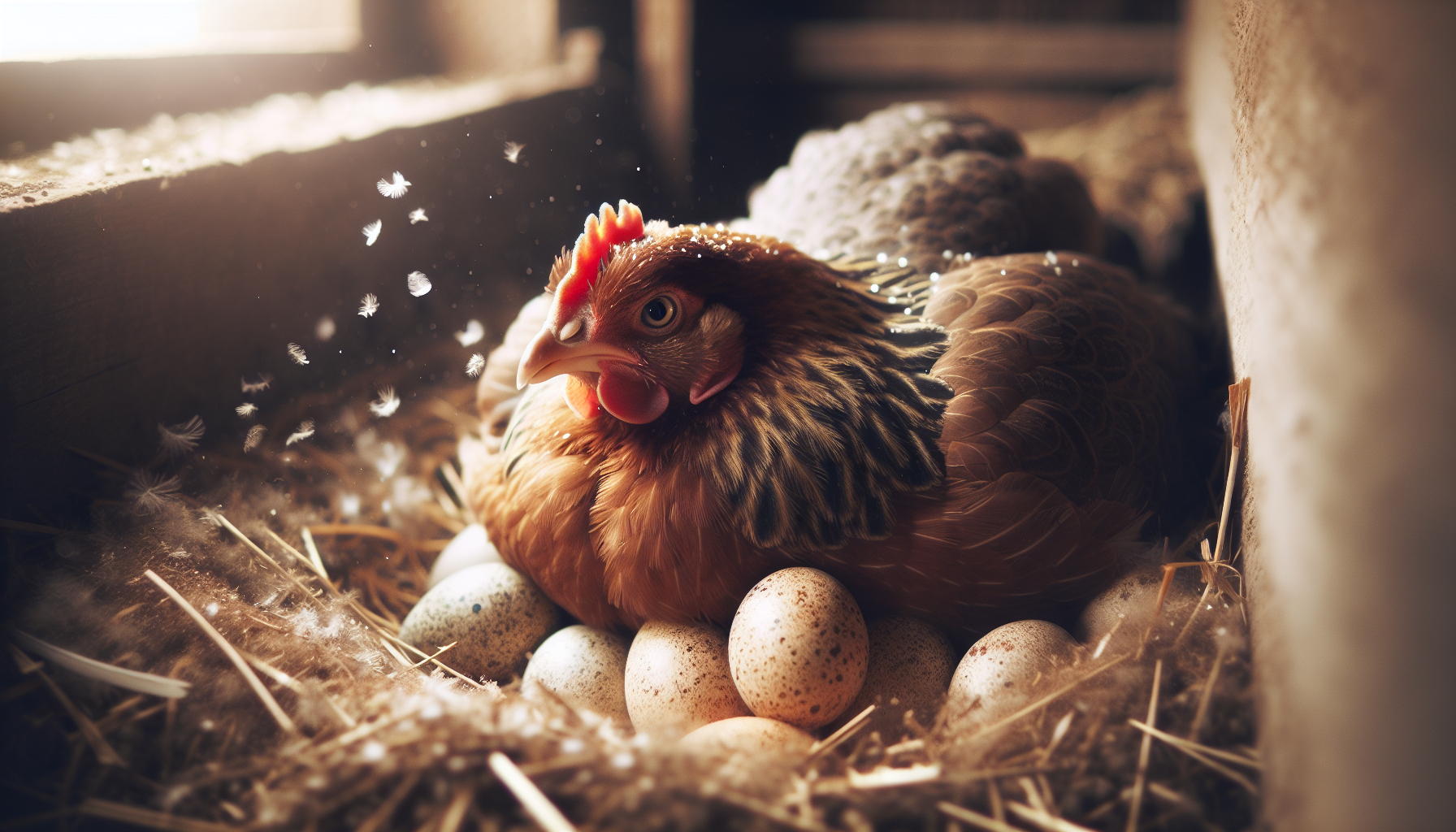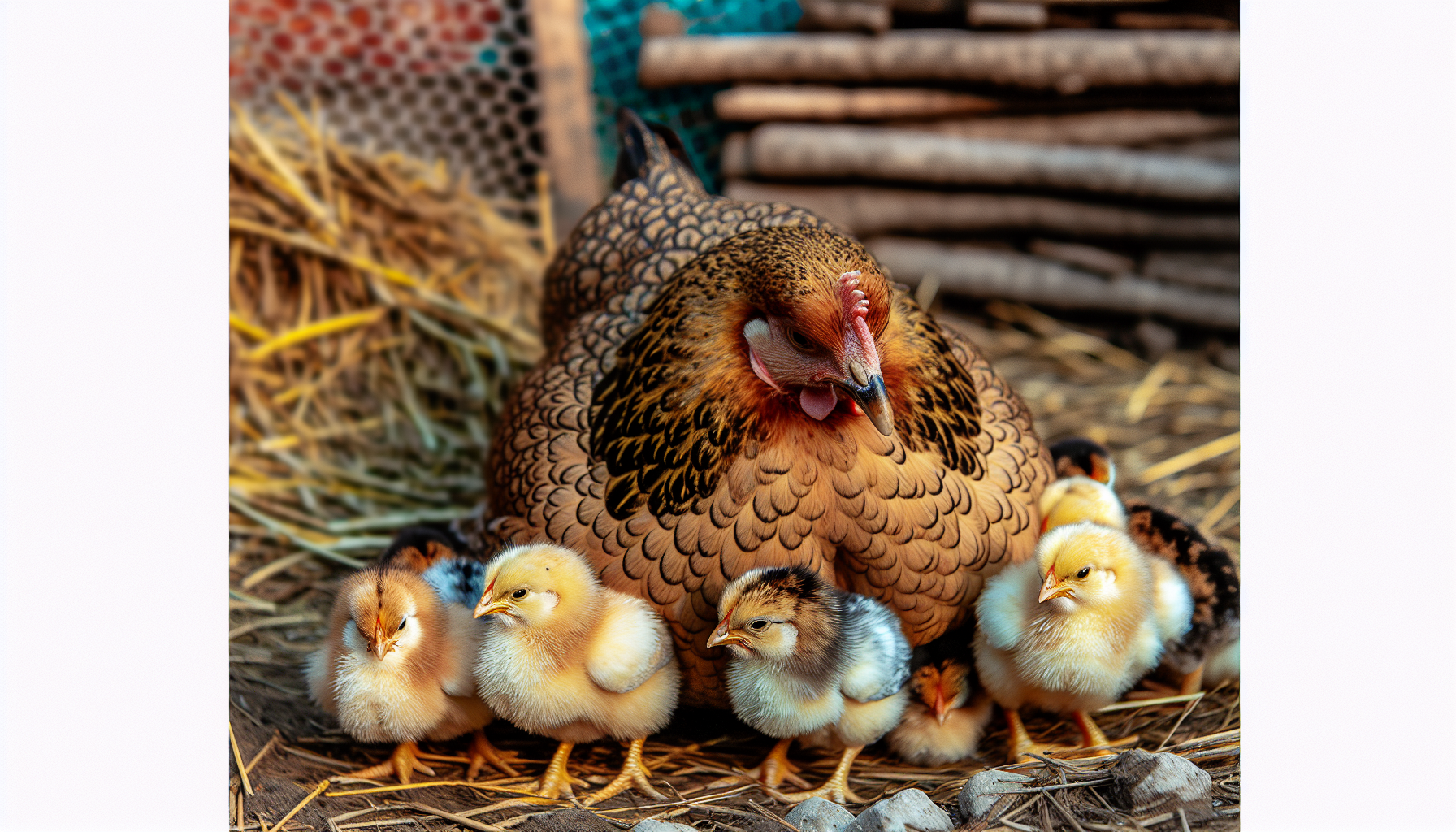Essential Insights into the Behavior of Chickens
Chickens are not mere backyard birds, but complex creatures with intricate behaviors. For anyone keen to understand or manage a flock, recognizing the pecking order’s influence, the necessity of dust baths, or the nature of broody hens is essential. Without excess adornment, this guide offers straightforward insights into the multifaceted behavior of chickens and what to expect from your feathered companions.
Understanding the Chicken Pecking Order
Much like high school cafeterias and corporate boardrooms, chicken flocks operate on a hierarchy system known as the ‘pecking order.’ This structure is more than just a playground for the tough and bossy; it forms a framework for order and peace within the flock.
Picture dramatic scenes of intimidation and pecking, all in the name of securing prime access to resources. This structure plays a key role in keeping the peace and reducing conflicts, as it informs each chicken of its position within the group.
Factors such as breed, health, and the presence of other roosters and hens can all influence a chicken’s standing in the pecking order. Just imagine the social maneuvering that occurs when a new member joins the flock or when a flock member passes away – it’s a world of intrigue and drama right in your backyard coop!
Dominance in the Flock

But who rules the roost in a flock of chickens? The dominant birds are typically the healthiest and toughest, acting as guardians and resource finders for the flock. They assert their authority through eye contact and, unsurprisingly, pecking. In flocks with more than one rooster, competition for the top spot can be fierce, mirroring the power struggles we often see in human society.
Dominant birds enjoy the privileges of their status, getting first dibs on food, water, and the best nesting spots. They maintain their dominance by ensuring other chickens know their place, reinforcing the established pecking order and keeping the peace among their flock mates. This dynamic needs to be grasped by chicken keepers for efficient flock management.
Submissive Birds’ Roles
At the other end of the pecking order are the submissive birds. These birds keep the peace by recognizing their place in the hierarchy and avoiding conflicts with their dominant counterparts. They show deference to superior birds, particularly when dealing with broody hens, who can become more aggressive and protective of their nests.
Submissive domestic chickens, or ‘henpecked’ birds, often find themselves at the bottom of the pecking order. They tend to be:
- shy and jumpy
- frequently on the receiving end of pecks from their more dominant flock mates
- they must wait their turn to eat, drink, and roost
- living a life of deference within the flock.
The Dynamics of Dust Bathing

Dust bathing, crucial to a chicken’s life, is much more than a mere cleaning routine. Chickens take dust baths to:
- Keep their feathers clean
- Rid themselves of parasites
- Absorb extra moisture and oil
- Exfoliate dead skin cells
- Maintain healthy skin
Imagine a hen wallowing in the dirt, rolling around and flapping her wings, a cloud of dust enveloping her – she’s not just having fun; she’s taking care of her health.
Chickens usually indulge in this spa-like activity once every two days. They pick a comfy spot in the dirt, settle down, and use their wings to throw dust over their bodies, providing a full-on grooming session. Instinct guides chickens to the prime dust bathing spots, typically sunny areas with loose, dry soil.
Social Aspects of Dust Baths
Dust bathing isn’t just a solitary activity; it’s also a social event for chickens. When one hen starts a dust bath, others often join in, turning the activity into a group relaxation session. This group activity helps strengthen the bond between flock members and reduce stress, enhancing flock harmony.
The pecking order even plays a role in dust bathing. The rank of the hens can determine who gets to use the dust-bathing areas, and they might even mimic each other’s dust-bathing behavior. It can be likened to a spa day in the chicken world, contributing to health, cleanliness, and particularly beneficial for laying hens.
Foraging: The Quest for Food
Natural to chickens, foraging resembles a treasure hunt, enabling them to seek food and discover their surroundings. When chickens have the freedom to roam, their diet becomes more diverse, including fresh greens and insects from outside. This variety is far more exciting and nutritious than the monotonous diet of cooped-up chickens, contributing to healthy chickens.
Insects like termites, ants, and grasshoppers, as well as wild greens like:
- sheep sorrel
- wild lettuce
- clover
- chickweed
are all part of the chicken’s wild buffet. It’s a culinary adventure for chickens every time they step out to forage.
Free Range vs. Confined Spaces
The liberty to roam markedly enriches a chicken’s foraging experience. Free-range chickens can develop more varied foraging behaviors and eat a wider array of foods, promoting better health and well-being. These chickens use the open space to their advantage, their foraging habits reflecting how they interact with their environment.
Conversely, chickens kept in coops may grapple with expressing their innate foraging instincts. The lack of space and variety can lead to frustration and aggression. However, chicken keepers can help by:
- Providing moving objects
- Offering live insects
- Using food-filled toys
- Regularly changing up these elements to stimulate the chickens’ foraging behavior.
The Life of a Broody Hen

A broody hen is like a fiercely protective mother, guarding her eggs and chicks with a devotion that’s remarkable to witness. Triggers such as:
- warm weather
- an accumulation of eggs in the nest
- decreased daylight
- the sight of baby chicks
Broodiness can be induced by various factors and typically lasts about 21 days – the same time it takes for birds to lay eggs and for fertile eggs to hatch, while unfertilized eggs remain unhatched.
Once the eggs are laid, the mother hen stops laying new ones and begins the incubation process. She sits on her eggs for approximately 21 days, keeping them warm and safe until they hatch. During this time, she becomes highly protective of her nest.
After the chicks hatch, her maternal duties continue as she keeps her chicks warm, responds to their peeps, and protects them from potential dangers during their first few weeks of life.
Read also: Safe Broody Breaker Methods: How to Break a Broody Hen
Preening and Grooming Practices
Chickens preen as an integral part of their grooming routine. They use their beaks to spread oil from a gland onto their feathers, keeping them in good condition and free from parasites. This grooming behavior is a regular part of a chicken’s day, with hens typically spending more time preening than roosters.
While preening, chickens use their beaks to clean and arrange their feathers. They also stimulate the oil gland at the base of their tails to secrete a lipid-rich substance, which they spread over their feathers. This ritual not only keeps them clean but also ensures the functionality of their feathers.
Group Preening
Preening often becomes a social event among chickens. They preen together, strengthening social bonds and ensuring all members of the flock are well-groomed. This group activity is more than just a communal grooming session; it has important implications for the health and appearance of the flock.
Group preening sessions are a time for chickens to bond and relax together. They help maintain healthy and functional feathers while strengthening the social bonds within the flock. It’s a win-win situation for the chickens – they get to socialize and keep their feathers in tip-top shape.
Vocalizations and Communication
Just like humans, chickens communicate with each other through a variety of vocalizations and displays. These sounds and gestures convey vital information about food, danger, and social interactions. Roosters and hens even have distinct vocalizations, with roosters being known for their loud crows that can reach around 100 dB, while hens rely more on a mix of vocal signals and body language.
When it comes to food, chickens have a sophisticated system of communication. They use specific sounds to let their flock mates know where the food is, ensuring everyone gets a bite. Such communication is paramount to the flock’s survival and overall health.
Read also: Understanding Chicken Communication: Sounds Explained
Nurturing Chicks: Mother Hen and Her Young

When it’s time for a hen to become a mother, her nurturing instincts kick in. As soon as the chicks hatch, she takes on the role of teacher, guide, and protector, teaching her chicks essential survival skills and behaviors through observation and imprinting.
The mother hen cares for her chicks by keeping them warm, responding to their peeps, and protecting them from potential dangers during their first few weeks of life.
Learning Through Observation
Chicks learn from their mother and other flock members by watching and mimicking their actions. This observational learning is critical for their development and integration into the flock. The mother hen shows her chicks the ropes by:
- Raising them alongside her
- Using unique clucking sounds to guide them
- Allowing them to pick up on basic life skills necessary for fitting in with the flock.
Watching their peers also influences a chick’s social growth. By watching their peers, chicks learn how to interact with the flock, where they fit in the social structure, and how to react to various situations. These lessons form the foundation of their behavior as they grow into adult chickens.
Seasonal Adaptations in Behavior
Chickens adapt their behaviors to the changing seasons, as chickens rely on specific strategies to cope with different weather conditions. In hot weather, they:
- Eat less
- Seek out shade and water
- Control their blood flow
- Cool down by panting
These adaptations help them survive in the heat and maintain their health.
Cold weather, on the other hand, can cause stress in chickens, leading to a drop in body temperature and changes in eating habits. This stress can make chickens more vulnerable, affect their nutrient absorption, and increase their energy use.
Comprehending these seasonal changes enables chicken keepers to offer year-round care for their flocks.
The Individuality of Chickens

Chickens are individuals with unique personalities and traits, which can vary depending on the chicken breed. These individual characteristics contribute to the dynamics and social structure of the flock. Just like humans, chickens show a range of personalities, from bossy to laid-back, which can determine where they stand in the pecking order.
Chickens’ unique personalities and chicken behavior can be observed especially when they’re free to roam. They respond to their environment in their own way, adding a layer of complexity to their interactions within the flock. Appreciating these individual traits affords a profound understanding of the social dynamics among chickens and their various chicken behaviors.
Frequently Asked Questions
What are Behavioural issues in chickens?
The most common behavioral issues in chickens are aggression and feather pecking. These can cause serious problems in the flock.
What do chickens act like?
Chickens are social animals that live in flocks and have a pecking order. They spend their time foraging for food and scratching the ground for insects and seeds, showing natural behaviors.
Why do chickens have a pecking order?
Chickens have a pecking order to maintain social order and determine access to resources within the flock, with dominant birds having priority. It’s a way for them to keep peace and establish a clear hierarchy.
What is a broody hen and how does she care for her chicks?
A broody hen is a hen ready to hatch and care for her chicks. She keeps her eggs warm and safe until they hatch, then protects her chicks from potential dangers during their first few weeks of life.
How do chickens communicate with each other?
Chickens communicate using vocalizations and gestures to convey information about food, danger, and social interactions within the flock. It’s their way of staying connected with each other.
Summary
From the pecking order’s social hierarchy to the communal dust baths and the nurturing behavior of mother hens, it’s clear that chickens lead complex social lives. Their behaviors are influenced by various factors, including their rank in the flock, the season, and their individual personalities.
Whether they’re foraging for food, grooming their feathers, or communicating with vocalizations, chickens display a range of behaviors that are both fascinating and complex.
So next time you observe a flock of chickens, take a moment to appreciate the intricate social world these birds inhabit.




